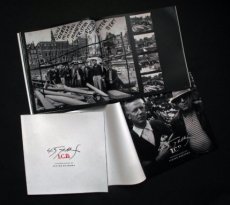Onverklaarbaar bewoonde woning, Boersma
ONVERKLAARBAAR BEWOONDE WONING
AFBRAAK, VERZET EN NIEUWBOUW IN AMSTERDAM -
VAN NIEUWMARKT TOT BIJLMER
In the end this resistance did not stop the underground line under construction, but the rest of the planned subway lines - having similar effects - were cancelled. The highway and office plans were scrapped also and social housing projects were implemented on the basis of a reconstruction of the historical street layout. This protest movement thus heralded a fundamental change of urban planning policy in Amsterdam.
The photographs cover a period of fourty years and show a landscape of 20th century urban transformations and social confrontations. Tjebbe van Tijen - one of the neighbourhood activists of that time - wrote a historical essay for this book.
The title "onverklaarbaar bewoonde woning" is a pun in Dutch meaning a 'habitated' house inspite of being officially declared 'uninhabitable'.
Annemarie De Wildt conservator Amsterdams Historisch Museum: "Niet esthetiseren, zo direct mogelijk zijn. 'Het lukte niet altijd met dat niet-esthetiseren,' zegt hij lachend als ik zeg dat sommige foto's toch ook prachtige composities zijn. Het is goed dat hij er was en op het juiste moment afdrukte. Dankzij fotografen als Pieter Boersma bestaan er beelden van dit recente verleden van Amsterdam en de strijd van bewoners tegen de 'city-vorming'."
Recensie van Han Schoonhoven: "Er ging veel mis bij de aanleg van de eerste metrolijn in Amsterdam, die vanaf de jaren zeventig het Centraal Station met de Bijlmer verbindt. Daarvan getuigt Onverklaarbaar bewoonde woning, de recente publicatie van Pieter Boersma. Fred Schmidt, van uitgeverij De Verbeelding, vond in Boersma's archief een groot aantal dramatische beelden. Activist, beeldhouwer en historicus Tjebbe van Tijen schreef er een geïnspireerde tekst bij. De kleinbeeld-zwart-wit foto's van Boersma zijn sober en staan volledig in dienst van het verhaal dat hij wil vertellen, zonder stylistische pretentie. Er gebeurde iets in een bepaalde omgeving en Boersma legde het vast zoals het was. Wanneer je al die foto's hebt bekeken zie je de kwaliteit ervan: duidelijker kun je het niet in beeld brengen."
Corrie Verkerk in 'Het Parool' van 11 september 2010: "Zijn archief bevat veel foto's uit de woelige Nieuwmarkt- en metroperiode. 'De tijd dat het stadsbestuur geen enkele prioriteit had voor stadsherstel,' aldus de tekst op de achterflap van zijn boek. 'Wel bestonden plannen om een metrolijn met daarbovenop een vierbaansweg dwars door de stad aan te leggen, waarbij hele wijken gesloopt zouden worden.' Bij het verzet daartegen was hij nauw betrokken. Boersma: "Die Nieuwmarktperiode wordt altijd vastgepind op de ontruimingen. Maar het ging ons vooral om het behoud van het oude stratenpatroon. Dat is gelukt."



